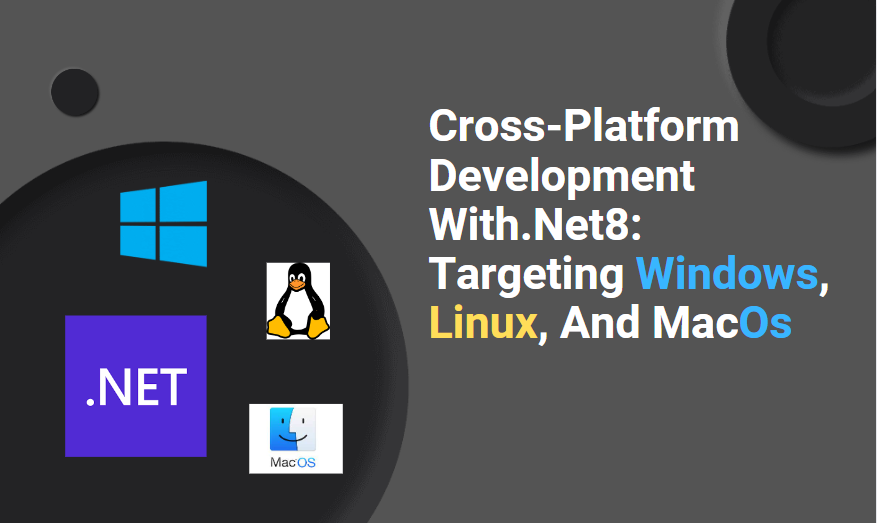As the software industry as a whole has progressed, so needs cross-platform products. The flexibility and speed of development are both increased by writing code that is readily portable to various systems. Cross-platform programming in .NET 8, and .net8 features and how it simplifies development on Windows, Linux, and macOS will be covered thoroughly.

The Evolution of .NET
The evolution of.NET was designed with programmers’ requirements in mind after its initial release as a Windows-only framework,.NET has evolved into a robust, cross-platform development system.
The advancement of cross-platform programming has reached a watershed point with .NET 8. Let’s check out the new cross-platform app development capabilities in .NET 8.
- Unified Platform: One Codebase, Multiple Platforms
.NET 8’s single-platform emphasis guarantees that all framework versions share the same codebase. This allows code to be developed once and utilized across platforms with little change. The same codebase for Windows, Linux, and macOS improves productivity, decreases maintenance costs, and unifies the user experience.
The.NET MAUI framework allows cross-platform interoperability. Xamarin started.NET MAUI development. Forms extensions provide a platform-independent UI for native app development. Writing once, developers may deploy to Windows, Linux, and macOS.
- Cross-Platform UI with .NET MAUI
A consistent user experience across platforms is difficult but essential for product success. Fortunately,.NET MAUI offers a consistent UI framework that isolates platform differences, simplifying this procedure.
With .NET MAUI, programmers can define a single UI that accounts for many platforms. Windows, Linux, and macOS run MAUI better. Its tools and layouts make it easy to create responsive and beautiful UIs.
- Cross-Platform APIs and Libraries
Free, open-source APIs and library formats. The user interface and NET 8’s standardized APIs and libraries allow cross-platform interoperability.
Resource-intensive tasks include file I/O and networking. These APIs may save programmers from writing platform-specific code.
This abstraction avoids platform-specific if/else statements, which is beneficial. The standard set of APIs in.NET 8 simplifies Windows, Linux, and macOS activities, including reading and writing files, connecting to networks, and using device-specific features.
- Platform-Specific Implementations
Reusing code between platforms isn’t always possible. .NET 8 solves this by universally implementing APIs throughout the platform, encouraging developer collaboration.
Due to these variations, platform-specific solutions benefit developers. Performance and platform-specific features may be used without a code modification.
- Performance and Optimise
Working cross-platform requires speed and consistency. With.NET 8, developers can build quicker, more responsive Windows, Linux, and macOS apps. Runtime and garbage collector improvements allow the just-in-time (JIT) compiler to create quicker machine code.
- Containerization and Deployment
Containerized apps are popular in software development, and .NET 8 supports them. Containers may let developers run code uniformly across platforms.
Containerization may speed up Windows Server, cloud Linux, and macOS deployments. Eliminating platform-specific settings and dependencies lets developers write secure apps.
- DevOps Integration and CI/CD Pipelines
DevOps would be inadequate without.NET 8, which is easy to install. CI/CD pipelines automate Windows, Linux, and macOS app development, testing, and release.
Developers can guarantee software works across platforms using DevOps tools and techniques. This enhances software quality and dependability while reducing production time.
- Community and Ecosystem
Every programming environment, including .NET, relies on its community and ecosystem. With.NET 8, cross-platform development frameworks, tools, and resources are more accessible.
The developer community drives.NET, creating a welcoming environment with forums and tutorials. The community helps developers of all levels learn, collaborate, and learn.
- Future-Proofing with Open Source and Standards
Microsoft’s .NET 8 framework remains open and extensible. To adapt to evolving customer expectations and technologies, .NET uses open standards and engages with the developer community.
Openness and consistency provide program continuity and foster innovation and cooperation. Developers may be certain that their code will be maintained and updated to meet future application and industry requirements by using the.NET framework.
Case studies: Real-world success stories
Let’s explore some real-world apps to assess the feasibility of using.NET 8 for cross-platform development on Windows, Linux, and macOS.
- Finance App for Multiple Platforms
To reach a larger audience, financial institutions upgraded their desktop software. Due to its usage of.NET 8 and.NET MAUI, the app’s source code may run on any platform. This means that in addition to Windows for businesses and Linux for servers, the program might be translated to macOS for usage in the creative sectors.
- Educational Software Across Devices
An educational software business wants to grow by offering its app on more mobile devices. Using.NET 8 and.NET MAUI, they created apps for Windows, Linux, and macOS tablets.
Large code reuse allowed the development team to enhance features quickly. Improved.NET 8 allows developers to create a single UI for all platforms.
- Healthcare Management System
Having a trustworthy management system that worked on a broad range of mobile devices was particularly crucial in the healthcare industry. The team utilized.NET 8 to design a solution that can be used by physicians on any operating system.
This covers iOS and macOS mobile devices and Windows and Linux PCs .NET 8’s platform-specific implementations mean quicker load times and a more polished overall product.
Language Enhancements: Making Code Simpler and Safer
New language features in.NET 8 simplify and improve code safety. These improvements make code readability and maintainability easier and reduce mistakes. Let’s examine these linguistic improvements:
- C# 10, introduced in.NET 8, makes pattern matching more powerful and expressive. Allowing developers to match data structure patterns and run code blocks simplifies conditional coding.
- C# 10’s new reference type Records provides immutable data types with a compact syntax. They make data-centric classes simpler to deal with and avoid unintended code changes
- .NET 8 includes interpolated string handlers, which let developers tailor interpolated string behavior. This functionality improves string manipulation and formatting
- .NET 8 advances C#’s nullable reference types functionality. It helps developers define reference type nullability more correctly, decreasing null reference exceptions.
- Improved Asynchronous streams are powerful for managing asynchronous data sequences. Asynchronous streams are simpler to use in.NET 8.
- The language improvements make C# code more readable, manageable, and safe. They help developers produce error-free, understandable code, enhancing productivity and program quality.
.NET Unification: Easy Code Sharing
Unifying the.NET environment is a major improvement in.NET 8. You can simply exchange libraries and components between.NET Framework, Core, and Xamarin. This single environment simplifies code administration, promotes code sharing, and expands development. .NET 8 unifies this way:
- With.NET 8, you may have one codebase for libraries and components. This code eliminates the need for several codebases and reduces maintenance for apps targeting different.NET platforms.
- .NET 8 libraries and components work across runtimes, assuring functionality.
- .NET 8 offers tools and assistance to transition older.NET libraries and components to the unified ecosystem, making codebase modernization simpler.
- The unified.NET ecosystem makes code sharing between teams working on various portions of an application or project easier and more efficient.
- Libraries and components work in online, desktop, cloud, and other applications.
- This unification simplifies development, minimizes duplication, and promotes code reuse across projects. The unified.NET environment improves code sharing and collaboration, whether you’re a single developer or a huge team.
Conclusion
.NET 8’s cross-platform capabilities help developers grow their app’s user base. By simplifying tiresome activities, the unified platform and.NET MAUI have increased productivity and morale.
In the next few years, cross-platform software testing will gain importance. Mobile app developers are adopting NET 8 due to its quick development cycles, versatility, and regular upgrades. Version 8, allows cross-platform app development. This applies regardless of.NET coding experience developers may create cross-platform apps more easily with.NET 8.
URL:
dot-net-8-development-for-cross-platform
Meta Title:
.Net8 Development for Cross Platform: Targeting Windows, Linux, And Macos
Meta Description:
Unleash the power of .NET 8 for seamless cross-platform development. Elevate speed, performance, and flexibility on Windows, Linux, and macOS.
Keywords:
.net8 features, cross-platform development,
Image Alt:
dot net development for cross platform
Hyperlinks:






